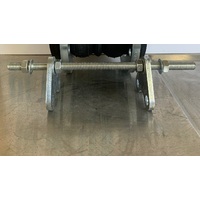FILTER PRODUCTS
Categories
Information
Control Rod Set - Rubber Expansion Joint Accessory
Control rods for rubber expansion joints are available in Australia with free delivery*. We can supply Control Rods for Rubber Expansion Joints to all cities in Australia, including Perth, Adelaide, Melbourne, Sydney, Brisbane, Darwin, Canberra and Hobart.
Always install Control Rods on Rubber Expansion Joints when movements are unknown and when pipe anchoring is unknown. Contact us for more information.
What are Control Rods for Rubber Expansion Joints/Flexible Bellows?
- Controls rods are also known as Tie Rods and Limit Rods. They are a metal rod or bar of steel which are slightly longer than the overall face to face length of the rubber expansion joint. Generally the rod or bar is threaded so that nuts can be screwed on and tightened to act as the limiting device, restricting movement past a certain point.
- The Control Rods are secured in position by being secured by nuts to a mounting plate, which mates to the flange of the rubber expansion joint.
- Control rods can be made from several metals, such as mild steel and stainless steel. Mild steel can be galvanised.
Why use and install Control Rods on Rubber Expansion Joints/Flexible Bellows?
- Control rods are an optional extra and should be fitted to rubber expansion joints when there is a possibility that there will be excessive movement which would result in the failure of the rubber expansion joint. Control rods are a safety device when installed to a rubber expansion joint.
- Where predictable movement is greater than the flexible design range of the rubber expansion joint. Can be compressive movement, elongation, angular and torsional movement.
- Control rods will prevent excessive movement and control and limit the movement and forces being applied to the rubber expansion joint.
- Control rods will increase the pressure rating of the Rubber Expansion Joint, and should always be installed on high pressure applications.
- Control rods are designed to control thrust pressure.
Variations available for Control rods:
- Depending on the controlling requirement for the movement of a rubber expansion joint, control rods can have variations for a different controlling outcome. It is important to know that the compression movement of a rubber expansion joint will shorten the overall length of the rubber expansion joint, so nuts or a compression sleeve fitted on the inside between the two flanges will prevent excessive compression movement and shortening of the rubber expansion joint.
- To control the compression movement of a rubber expansion joint, a Compression Sleeve can be installed inbetween the two flanges of the rubber expansion joint. The Compression Sleeve, is a solid hollow bar, which slides over the control rod, therefore removing the requirement for nuts to be fitted on the inside of the two flanges.
- Another movement is the elongation of the rubber expansion joint, which increases the overall length of the rubber expansion joint. To control the elongation movement two nuts need to be screwed onto the outside edge past the flange, to act as stoppers, so that when the flange moves and hits the control nuts, the movement will be stopped.
- In cases where elongation movement is the only concern, then no nuts or a compression sleeve are required to be fitted on the inside between the two flanges. Two nuts fitted on the outside of each flange will only be required to control the elongation movement, angular movement, and torsional movement. Two nuts tightened together with the inner nut position a set distance from the flange of the rubber expansion joint.
Ordering Control rods for Rubber Expansion Joints:
- To accurately supply the correct control rods, we need to know the DN size of the rubber expansion joint, the face to face dimension of the rubber expansion joint, and the flange specification on both sides. This will ensure that the mounting plate will be machined correctly to match the flange holes on the rubber expansion joint, and that the correct length of control rods is supplied to function properly when the rubber expansion joint is installed.
How to install a Control rod to a Rubber Expansion Joint:
- Each control rod will be supplied with two mounting plates, so that one mounting plate can be fitted to each flange of the rubber expansion joint. Fit the mounting plates to the flanges, spaced evenly around the flange to assist in the force distribution between the control rods. A minimum of two control rods must always be installed to one rubber expansion joint.
- Please note: Compression nuts or a compression sleeve will need to be fitted before bolting the mounting plate to the flange. As you wont be able to get them on once the mounting plate has been bolted to the flange. Make sure that the nearest nut to the flange is set at the desired movement distance, for example 5mm from the flange, if the compression movement is to be a maximum of 5mm.
- Use the flange bolts to secure the mounting plate to the flange. Longer bolts may be required for the specific flange holes where the mounting plate fits on.
- When elongation nuts are only being installed, now is the time to insert the rods through the mounting plate top holes.
- Two nuts needs to be screwed onto the outer side of each flange. Set the first nut nearest the flange to the desired distance from the flange, such as if elongation is to be a maximum of 10mm, then set the nut 10mm from the flange. Ensure the second nut is screwed tigthly up against the first nut, so that they will be secured in place.


